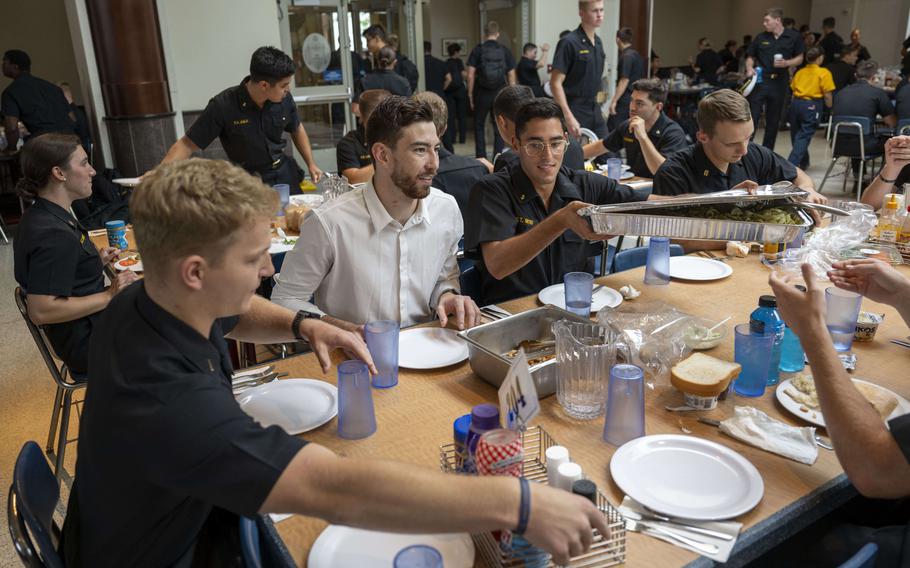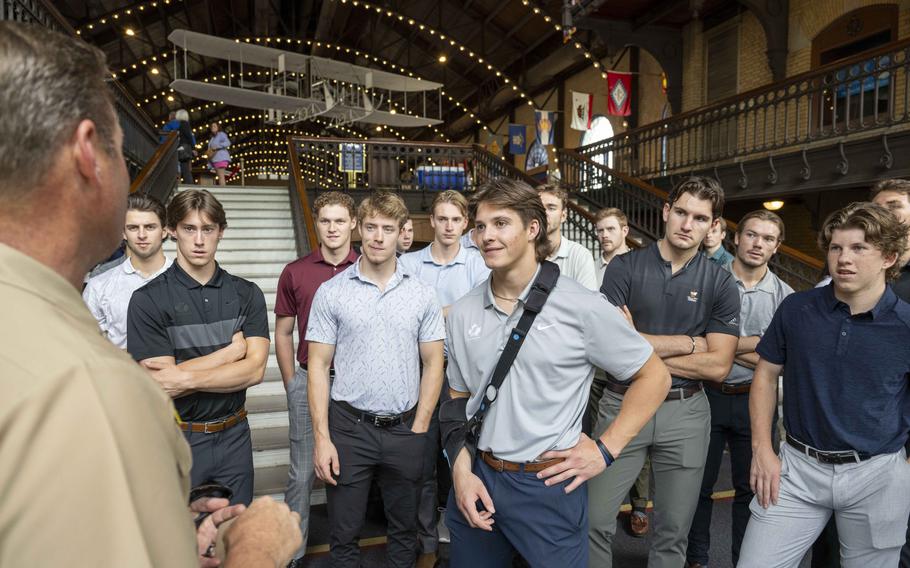
The Capitals traveled to the Naval Academy during rookie camp this year. (Jonathan Newton/The Washington Post)
Across the NHL over the past week, rookies and young players have taken to the ice for prospect tournaments and showcase games designed to give them an early taste of a competitive environment. But players who participated in the Washington Capitals’ rookie camp were met with a different kind of challenge: a trip to the U.S. Naval Academy in Annapolis.
The risk of injury in a prospect tournament prompted Washington to change the structure of its rookie camp, an event for drafted prospects and early- career pros. The Capitals were one of only three of 32 NHL teams that chose not to participate in a tournament, but they still wanted rookies to have a meaningful experience — more meaningful than simply spending a few days skating in Arlington before training camp begins Thursday.
The organization wanted prospects to build confidence and prepare for training camp, and the trip provided them a chance to bond as a group in a lower-pressure environment before they get on the ice with NHL players.
“It’s almost part of a team-building thing,” assistant general manager Ross Mahoney said. “Getting away from the facility in Washington and coming down here, spending some time and kind of exposing the kids to a little bit of a different environment.”
Aimee Kimball, the Capitals’ senior director of team and organizational development, took a preseason trip to the Naval Academy in 2019, when she was working with the New Jersey Devils. Kimball joined the Capitals in 2021, and she contacted Jessica Mohler, the Naval Academy’s sports psychologist and a longtime friend, to discuss a similar trip for this year’s rookie camp.
Twenty-one players hit the ice Saturday afternoon in Arlington before traveling to Annapolis for three days of practices at McMullen Ice Arena and team-building activities in conjunction with the Naval Academy.
“For us, a lot of it is to get them outside of what’s normal for them and to show them that there’s more in the world,” Kimball said. “At an academy like this, they learn a lot about sacrifice and commitment and dedication, and how hard it really is — not just in hockey, but in life — to be successful.”
Before heading out to Annapolis, the prospects weren’t given much insight into what the trip would entail.
“I’d love to tell you what we’re going to learn and stuff like that, but it’s kind of a surprise in a way,” forward Hendrix Lapierre, 21, said Saturday. “I know we’ll be on the ice in the morning and we’ll have a bunch of meetings, stuff like that. I’m sure it’ll be really exciting.”

The trip provided rookie participants a chance to bond as a group in a lower-pressure environment before they get on the ice with NHL players. (Jonathan Newton/The Washington Post)
The scope of the trip went a bit beyond having a bunch of meetings. After Sunday’s practice, the Capitals went to the Naval Academy’s “confidence course” — a combination obstacle course and military training exercise. Completing the course is part of the grueling summer training, known as Plebe Summer, which the midshipmen undergo before their freshman year. It requires participants to work in pairs as they navigate ropes, logs and platforms that can be as high as 40 feet off the ground.
Eventually, whether it begins this week or comes a year or two down the line, the players from rookie camp will be competing against one another for NHL jobs in Washington. But the Capitals also want to reinforce the idea that they’re future teammates.
“They’re young Capitals right now, so that’s all part of filtering up,” Mahoney said. “Hopefully, X amount of them end up playing in the NHL. It’s all part of being in the Capitals organization and the pride that you have. This is kind of where it starts.”
Monday’s activities were less physically demanding, but there was no shortage of mental engagement as the prospects toured the Naval Academy. The Navy men’s and women’s club hockey teams hosted the Capitals for lunch in King Hall — where all 4,500 midshipmen eat together three times a day — and the prospects broke off into small groups to join the midshipmen at their usual tables, learning about their daily lives along the way.
Many players’ eyes widened when they learned that the schedule at the academy involves a 6:30 a.m. wake-up, a strict timetable throughout the day, a mandatory study period after dinner and an evening curfew.
“It definitely takes lots of discipline to be on time all the time and not be late,” forward Ryan Hofer, 21, said. “Especially with not a lot of sleep, and they still have to do it. Can’t really complain. Just have to do it and be disciplined with yourself. Obviously, the end goal is very serious, so they’re more than willing to do it. I think it’s very cool, and I respect it a lot.”
After lunch, Col. Michael Styskal, the highest-ranking Marine on campus, spoke to the group about the Navy’s character development curriculum. Many of the prospects work with sports psychologists and have been exposed to mental skills training, but the conversation took familiar concepts to new heights. Terms such as resilience, grit and mindfulness — all of which are staples when talking about the mental side of sports — gain another level of meaning when considered through the lens of preparing someone mentally to go into battle.
Playing a hockey game isn’t comparable to going off to war, but by opening the players’ eyes to an entirely different world than the one they live in, Kimball’s hope is that the players take what they learned in Annapolis and apply it to their lives, on and off the ice.
“Being here, they can see that environment of finding a purpose beyond yourself,” Kimball said. “That’s something as an organization that we value, the sacrifice for the team. I think somewhere like this can teach them that, and at a young age, it’s an important lesson for them to have.”